The AMD Radeon R9 295X2 Review
by Ryan Smith on April 8, 2014 8:00 AM EST- Posted in
- GPUs
- AMD
- Radeon
- Radeon 200
Revisiting the Radeon HD 7990 & Frame Pacing
Before we jump into our full benchmark suite, the launch of a new AMD dual-GPU card makes this an opportune time to revisit the state of frame pacing on AMD’s cards and to reflect on the Radeon HD 7990, so we’d like to take a moment to do just that.
When the 7990 launched last year, for AMD it came at an unfortunate time when the subject of frame pacing was finally coming to a head. With the incredibly coincidental release of NVIDIA’s FCAT tool it became possible to systematically and objectively measure frame pacing, and those findings showed that AMD’s frame pacing algorithms were significantly lagging NVIDIA’s. AMD Crossfire setups, including the 7990, were doing little if anything to mete out frames in an even manner, resulting in a range of outcomes from badly paced frames to dropping frames altogether. Worse, the problem was especially prevalent on multi-display Eyefinity setups, including the pseudo-multi-display methods that are used to drive 4K monitors at 60Hz even today.
The issue of frame pacing had been brewing for some time and AMD was quick to respond to concerns and agree that it needed addressed, but the complex nature of the problem meant that it would take some time to fully resolve. The result of AMD’s efforts resulted in a series of phases of Crossfire frame pacing improvements. Phase 1 was released in August, 4 months after the launch of the 7990, and implemented better Crossfire frame pacing for games operating at or below 2560x1600.
The 2560x1600 limitation was a significant one, as this essentially limited AMD’s fixes to single-display setups and excluded Eyefinity and 4K setups. This limit in turn was directly related to the technical underpinnings of AMD’s GCN 1.0 (and earlier) GPUs, which used the Crossfire Bridge Interconnect to share data when using Crossfire. The CFBI offered just 900MB/sec of bandwidth, which was enough for 2560x1600 but nothing more. To move larger frames between GCN 1.0 GPUs, AMD has to undertake a much trickier process of involving the PCI-Express bus.
In the intervening period between then and now AMD has released their GCN 1.1 GPUs, which implement the XDMA block to specifically and efficiently handle frame transfers between GPUs. The end result of the XDMA block is that Hawaii based products – including the R9 295X2 – have no trouble with frame pacing. This in turn makes the R9 295X2 all the more important for AMD due to the fact that it’s the first dual-GPU video card from them to utilize this feature. Otherwise for the 7990 and other GCN 1.0 products, utilizing Crossfire with high resolutions involves a great deal more effort under the hood.
It was only finally in February of this year that AMD rolled out their Phase 2 driver, which implemented their high resolution frame pacing solution for pre-GCN 1.1 video cards. But since that same driver also launched support for AMD’s Mantle API and their Heterogeneous System Architecture, we haven’t had a chance to reevaluate AMD’s frame pacing situation until now. In our full benchmark section we’ll include a complete breakdown of frame pacing performance for both AMD and NVIDIA setups, but we first wanted to stop and take a look at frame pacing for pre-GCN 1.1 cards in particular.
So we’ve set out to answer the following question: now that AMD is supporting high resolution frame pacing on cards such as the 7990, has the 7990 been fully fixed?
The short answer, unfortunately, is that it’s a mixed bag. AMD has made significant improvements since we last evaluated frame pacing on the 7990 back at the 290X launch, which at the time saw the 7990 dropping frames left and right. But AMD has still not come far enough to truly fix the issue, as we’ll see.
We’ll starting off with our delta percentage data, which is the average difference in frame times as a percentage. In an ideal world this number would be 0, indicating that every frame was delivered in exactly as much time as the previous one, which would give us a perfectly smooth experience. In practice however this is impossible to achieve even in a single-GPU setup, let alone a multi-GPU setup. So for multi-GPU setups our cutoff is 20%; if a GPU can deliver a frame with a variance of no more than 20% of the time the previous frame took, then the frame delivery is consistent enough that gameplay should be reasonably smooth and below the bounds of human perception, even if it’s not perfect.
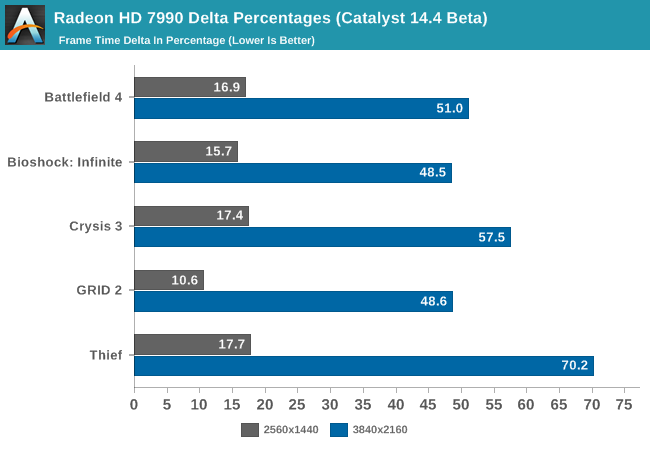
The end result, as we saw back in August with Catalyst 13.8, is that AMD’s frame pacing situation has been brought under control in single-display (2560x1440 and lower) resolutions, as AMD was able to continue using the CFBI and merely changed their algorithms to better handle frame pacing.
However the state of frame pacing for high resolution Crossfire, when invoking the PCIe bus, is still fundamentally broken. Of the games we have that scale with multiple GPUs, the best game is Bioshock: Infinite with a 48.5% delta, 3x the variance of 2560x1440. It gets worse from there, going up as high as 70% for Thief. To be clear this is significant improvement over the 7990 that was dropping frames before AMD’s latest fix, but the deltas are still more than twice what we believe the cutoff should be.
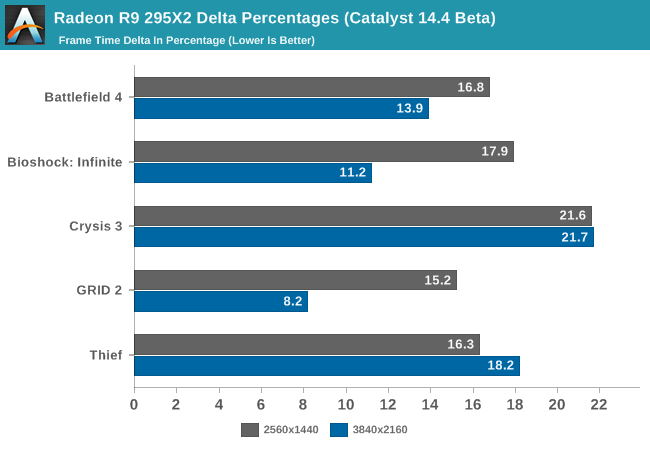
The Radeon R9 295X2 by comparison fares much better. Not only are AMD’s deltas below 20% on everything but Crysis 3 (where it’s essentially skirting that value), but in most of our games the variance drops with the increased resolution, rather than massively increasing as it does with the 7990. This is the kind of chart we’d like to see for the 7990 as well, and not just the R9 295X2.
Our final graph is a plot of frame times on both cards on the main menu of Thief, showcasing how the cards compare and giving us a visual for just what’s going on. As our delta percentages picked up on, the 7990’s frame times are all over the place, with the card frequently cycling between 15ms frame times and 30ms frame times. This is as opposed to the R9 295X2, which is relatively consistent throughout.
What makes this all the more interesting though – and is something we’ve seen on other charts – is that the 7990’s variance drops towards the end. It’s still unquestionably worse than the R9 295X2 and exceeds our 20% threshold, but compared to the worst point on the chart it has come close to being halved.
This data indicates that for the pre-GCN 1.1 cards AMD is relying on some kind of long term adaptive timing mechanism that takes quite some time (at least a minute) to kick in. Only after which do AMD’s frame pacing mechanisms exert enough control to better regulate frame timings. We’ve known since the launch of the 290X that AMD is using some kind of short term adaptive timer for the 290X and single-display resolutions on pre-GCN 1.1 cards, but this is the first time we’ve seen a long term adaptive timer in use.
The end result is that in extended play sessions the frame pacing situation on the 7990 should be better than what we’re seeing with our relatively short benchmarks. However it also means that the initial frame pacing situation will be very bad and that in the best case scenario even after a few minutes the frame timing variance is still much higher than the 20% threshold it takes to make the frame times reasonably consistent.
To that end, though the 7990 is much improved, it’s hard to say that the frame pacing situation has been fixed. To be sure single-display is fine and has been fine since August, but even with AMD’s most recent changes the 7990 (and presumably other pre-GCN 1.1 cards) are still struggling to display frames at an even pace. Which for a card originally touted as the perfect card for 4K, is not a great outcome.


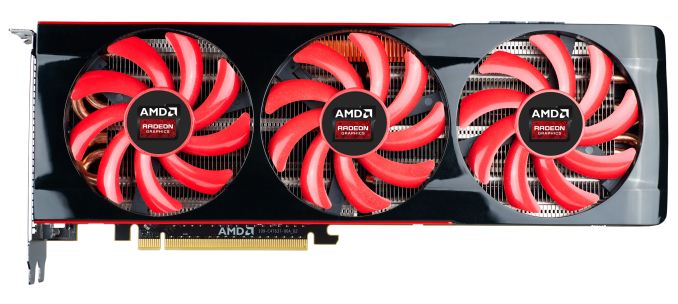
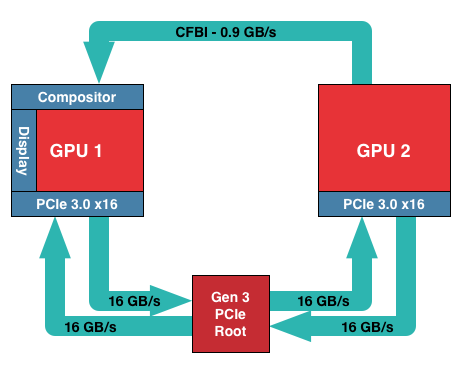
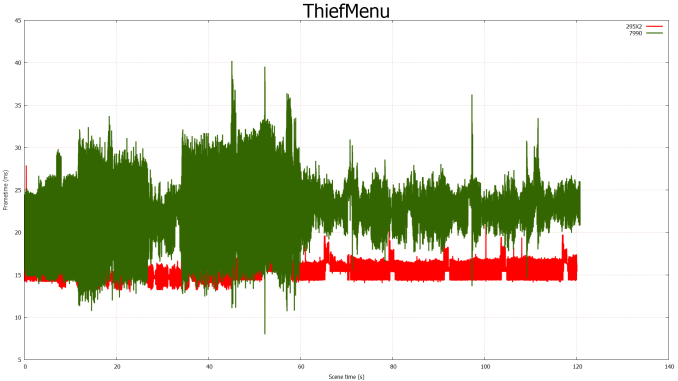








131 Comments
View All Comments
ruggia - Tuesday, April 8, 2014 - link
I'm looking at results from pcper and toms too and I see nothing "broken". In most cases variances are better than 780 sli or low enough to not be an issuemagnusmundus - Tuesday, April 8, 2014 - link
With a closed loop cooler for both GPU and CPU, you might as well go for a full custom loop and get better cooling and nicer aesthetics.kyuu - Tuesday, April 8, 2014 - link
Er... no? Two CLCs are still quite a bit different from setting up a custom loop.cknobman - Tuesday, April 8, 2014 - link
Your gaming test suite kinda sucks, please update it.Ryan Smith - Tuesday, April 8, 2014 - link
The gaming test suite is a constant work in progress, so we're always looking for new games to add to it.Do you have anything in particular you'd like to see? (Keeping in mind that it needs to be practical to benchmark it)
Earballs - Thursday, April 10, 2014 - link
Titanfall at or above 1440 would be most lovelyjkhoward - Thursday, April 10, 2014 - link
I still think that WoW should still be included in these benchmarks..devione - Tuesday, April 8, 2014 - link
Is it really impossible to cool this card without using an AIO cooler, like the Titan Z?mickulty - Tuesday, April 8, 2014 - link
That would require either huge amounts of binning that drives price right up (like the Titan Z), and/or significant reductions in clock speed to accommodate reduced voltage (almost certainly like the Titan Z), resulting in a card that's both overpriced and underpowered (like...). Of course, it's not really fair to compare a card that's with reviewers now and on the shelves in 2 weeks with a card that has only ever been seen as a mockup on one of nvidia's slides =).devione - Tuesday, April 8, 2014 - link
Fair points.I just have an irrational dislike for AIO coolers. I would hope to see custom aire cooled via 3rd party variants, but for a variety of practical reasons I doubt that is going to happen.